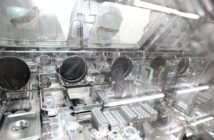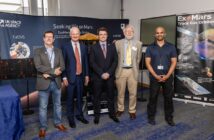The European Space Agency’s (ESA) Euclid mission, supported by UK scientists at The Open University (OU) has unveiled new stunning images of stars and galaxies, forming the first section of its cosmic atlas.
This first chunk of the map, which is a huge mosaic of 208 gigapixels, was revealed today at the International Astronautical Congress in Milan, Italy, by ESA’s Director General Josef Aschbacher and Director of Science Carole Mundell.
The mosaic contains 260 observations made between 25 March and 8 April 2024. In just two weeks, Euclid covered 132 square degrees of the Southern Sky in pristine detail, more than 500 times the area of the full Moon.
This mosaic accounts for 1% of the wide survey that Euclid will capture over six years. During this survey, the telescope observes the shapes, distances and motions of billions of galaxies out to 10 billion light-years [1]. By doing this, it will create the largest cosmic 3D map ever made.
This first piece of the map already contains some 14 million galaxies that could be used to study the hidden influence of dark matter and dark energy on the Universe. It also contains tens of millions of stars in our own Milky Way.
The Open University’s Centre for Electronic Imaging (CEI) helped to develop the detectors for the VIS instrument, which takes the images and tested how they would perform in the harsh radiation environment in space.
The team has continued to monitor the detectors during the mission, allowing Euclid to return the best possible images and data for the mission’s lifetime.
Dr Jesper Skottfelt, Research Fellow at the OU, says:
“The Euclid mission is a major step forward in our understanding of the dark universe. The images Euclid is capturing are a treasure trove of information that will help us unravel the mysteries of dark matter and dark energy.
“The success of this mission depends on the quality of the images, and that’s where the work of Teledyne-e2v and the CEI is so important. Teledyne-e2v developed the cutting-edge CCD detectors that are at the heart of Euclid’s camera, and the CEI is working to correct for the effects of radiation damage on these detectors, ensuring that we get the most out of these precious images.”
The spacecraft’s sensitive cameras captured an incredible number of objects in great detail. Zooming very deep into the mosaic (this image is enlarged 600 times compared to the full view), we can still clearly see the intricate structure of a spiral galaxy.
A special feature visible in the mosaic are dim clouds in between the stars in our own galaxy, they appear in light blue against the black background of space. They are a mix of gas and dust, also called “galactic cirrus” because they look like cirrus clouds. Euclid is able to see these clouds with its super sensitive visible light camera because they reflect optical light from the Milky Way. The clouds also shine in far-infrared light, as seen by ESA’s Planck mission.
Dr Ben Dryer, Research Fellow at the OU, added:
“It is remarkable that Euclid is producing such high-quality images despite the challenges of operating in a harsh radiation environment. The Sun has been particularly active lately, which has caused the Northern Lights to extend down beyond the south of the UK. This activity increases the radiation levels in space, which can damage sensitive electronics like those in Euclid’s camera.
“However, through research performed at the OU over the past decade, the Euclid team can understand and correct this damage to retain the best possible image clarity, and the results speak for themselves: Euclid is delivering stunning images of the cosmos.”
The mosaic released today is a teaser for what’s to come from the Euclid mission. Since the mission started its routine science observations in February, 12% of the survey has been completed. The release of 53 square degrees of the survey, including a preview the Euclid Deep Field areas, is planned for March 2025. The mission’s first year of cosmology data will be released to the community in 2026.
[1] When we refer to distances in light-years, we refer to the time that the light has travelled in space to reach our telescopes (light travel time). In one year, light travels 9.5 million million kilometres.



